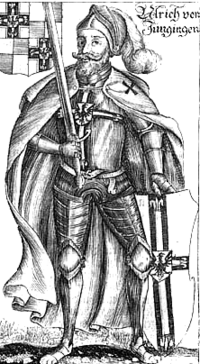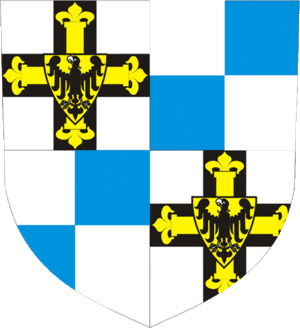Ulrich von Jungingen facts for kids
Quick facts for kids Ulrich von Jungingen |
|
|---|---|
| Hochmeister | |

17th century depiction by Christoph Hartknoch
|
|
| Grand Master of the Teutonic Knights | |
| Reign | 1407–1410 |
| Predecessor | Konrad von Jungingen |
| Successor | Heinrich von Plauen |
| Born | 1360 Hohenfels |
| Died | 15 July 1410 (aged 50) Grunwald, State of the Teutonic Order |
| Burial | Chapel of St. Anne, Malbork Castle |
| House | House of Jungingen |
Ulrich von Jungingen (born 1360 – died 15 July 1410) was a powerful leader. He was the 26th Grand Master of the Teutonic Knights. This was a very important position, like being the head of a large military and religious group. He led the Knights from 1407 to 1410.
Ulrich's decisions led to a big war called the Polish–Lithuanian–Teutonic War. This war was against the Grand Duchy of Lithuania and the Kingdom of Poland. It ended badly for the Teutonic Knights and for Ulrich himself. He died in a famous battle called the Battle of Grunwald.
Contents
Early Life and Rise to Power
Ulrich was born around 1360 into a noble family from Swabia, a region in Germany. He likely grew up at Hohenfels Castle, near Stockach. His family's main home in Jungingen had been destroyed earlier.
Ulrich and his older brother, Konrad von Jungingen, were younger sons. This meant they would not inherit their family's lands. So, they decided to join the Teutonic Knights. They moved to the Knights' territory in Prussia.
Becoming a Leader
Ulrich lived in a place called Schlochau (now Człuchów in Poland). From 1396 to 1404, he served as a Komtur of Balga. A Komtur was a local commander, managing a part of the Knights' lands.
His career got a big boost because of his brother Konrad. Konrad was elected Grand Master in 1393. Ulrich helped the Knights in important ways. For example, in 1398, the Knights removed some pirates called the Victual Brothers from Gotland island. Ulrich then helped in talks with Queen Margaret I of Denmark about who owned the island.
He also went on important trips to Poland and Lithuania. These trips helped create the 1398 Treaty of Salynas. This treaty was about the Duchy of Samogitia, a region that caused many problems later.
Marshal of the Order
In 1404, Ulrich became the Order's Marshal. This meant he was the main military leader. He was also the Komtur of Königsberg. He had to deal with several rebellions in Samogitia. He tried to stop these uprisings by using force and by giving money to local nobles.
When his brother, Grand Master Konrad von Jungingen, died suddenly in 1407, Ulrich was chosen to take his place. He became the Grand Master on June 26.
The Road to War
Ulrich was not as good at talking and making deals as his brother. The situation in Samogitia remained very tense. Vytautas the Great, the Grand Duke of Lithuania, was encouraging the people there to rebel. He wanted to get back the lands that Lithuania had given up.
Also, Ulrich inherited a growing conflict with King Jagiełło of Poland. Jagiełło was Vytautas's cousin. They argued over lands like Dobrzyń Land and the Neumark region. The Polish ambassador warned Ulrich that attacking Lithuania would mean war with Poland too.
Preparing for Conflict
Even with the risk of fighting on two fronts, Ulrich decided to prepare for war. He made an alliance with King Sigismund of Hungary. He also hired soldiers from the Holy Roman Empire. On August 6, 1409, he officially declared war against Poland.
King Sigismund did not send help to Ulrich. Sigismund was busy with his own problems. But the Teutonic Knights' army still had early success. They fought in Dobrzyń and Kuyavia and surrounded the city of Bydgoszcz.
King Wenceslaus IV of Bohemia, Sigismund's brother, arranged a short ceasefire. He tried to help Poland and the Knights make peace, but it did not work.
The Battle of Grunwald
On July 2, 1410, Grand Master Ulrich left Malbork Castle with his army. They were heading for a final battle against the combined forces of Poland and Lithuania.
The two armies met on July 15. The battle took place between the villages of Grunwald and Stębark. It was around noon, and neither army was moving.
A Bold Challenge
According to old stories, Ulrich sent two swords to King Jagiełło. He said that Jagiełło and Vytautas could "live or die by them." This was a very bold challenge. It made the Polish and Lithuanian forces attack.
The Knights first pushed back the attack. But then, King Jagiełło's forces attacked again. Ulrich, feeling sure of victory, decided to lead his remaining soldiers himself. He almost reached King Jagiełło. But by doing this, he lost control of the Knights' overall battle plan.
The End of the Battle
Some of the Knights' allies, like the Lizard Union, left the battle. This left Ulrich facing many more Polish and Lithuanian soldiers. When the Lithuanians attacked him from behind, Ulrich's troops were defeated. He was killed in action during the battle.
A Polish writer named Jan Długosz wrote that a Polish knight named Mszczuj of Skrzynno defeated Ulrich. King Jagiełło made sure Ulrich's body was taken back to Malbork Castle. After the battle, Jagiełło began the siege of Marienburg.
Remembering Ulrich von Jungingen
Later writers, like Jan Długosz, described Ulrich von Jungingen as hot-headed and proud. The famous painting Battle of Grunwald by Jan Matejko shows Ulrich in white with a black cross. He is shown trying to attack Grand Duke Vytautas when he is killed by two Polish soldiers.
Another writer, Henryk Sienkiewicz, wrote a novel called The Knights of the Cross in 1900. In this book, Ulrich is shown as an impulsive and aggressive commander. This book was made into a film in 1960.
However, some German historians in the 1800s saw Ulrich differently. They described him as a brave knight who was tricked by his enemies. The author Ernst Wichert wrote about this in his novel Heinrich von Plauen.
Memorials
Ulrich's successor, Heinrich von Plauen, built a small chapel on the battlefield in 1413. This chapel was likely destroyed later.
In 1901, a large stone called the Jungingenstein was placed there. It honored Ulrich's "hero's death." This stone is still there, but it has fallen over, and you can no longer read the words on it. A newer stone nearby marks the exact spot where Ulrich died. Today, the area is used for an annual historical reenactment of the battle.
Images for kids



